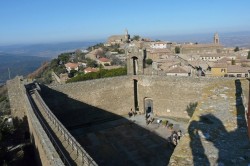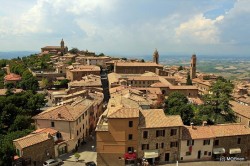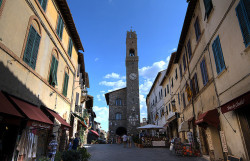 Montalcino – a small town (having about 5000 inhabitants), located in the province of Siena .Archaeological findings show that the area has been inhabited already in Etruscan and Roman times. In the 814s Emperor Ludovico il Pio gave the village of Montalcino to the monks of Sant’Antimo monastery. They managed not only religious but also political and administrative life of the town. In the 10th century, a lot of people moved from the seaside to Montalcino – they were hiding from the Saracen pirates who were attacking the Mediterranean coast. The expanded settlement began to flourish – it developed agriculture, ceramics manufacturing, shoemaking, wool processing. In the 12th century, due to the city of Siena, a high defensive wall appeared around Montalcino, and the town itself had depended on Siena for a long time until it was conquered by Florence.
Montalcino – a small town (having about 5000 inhabitants), located in the province of Siena .Archaeological findings show that the area has been inhabited already in Etruscan and Roman times. In the 814s Emperor Ludovico il Pio gave the village of Montalcino to the monks of Sant’Antimo monastery. They managed not only religious but also political and administrative life of the town. In the 10th century, a lot of people moved from the seaside to Montalcino – they were hiding from the Saracen pirates who were attacking the Mediterranean coast. The expanded settlement began to flourish – it developed agriculture, ceramics manufacturing, shoemaking, wool processing. In the 12th century, due to the city of Siena, a high defensive wall appeared around Montalcino, and the town itself had depended on Siena for a long time until it was conquered by Florence.
Such Montalcino remained up till now – a small town of the 16th century, reminding the decorations of historical films, stretching over the hill crest, framed by a church from one side, and a fortress from another. There are green oaks, olive trees and yellow flowering bindweeds covering the slopes, and narrow paths running through them and leading to vineyards. Due to them, i.e. the Brunello di Montalcino wine, the town became famous not only in entire Italy but also well-known among the wine connoisseurs from all around the world.
 However, it is worth visiting Montalcino not only because of its excellent red wine. Firstly, a powerful fortress, built in 1361 with the help of Siena, catches visitor’s eye. Tourists can visit the fortress and climb up the well-preserved bastions to take a look at beautiful surroundings: in case of nice weather, it is possible to see the contours of the extinct Monte Amiata volcano and Val d’Orcia valley that is stretching far away. During the warm season, very often various concerts and other cultural events take place in the fortress, as well as a wine shop.
However, it is worth visiting Montalcino not only because of its excellent red wine. Firstly, a powerful fortress, built in 1361 with the help of Siena, catches visitor’s eye. Tourists can visit the fortress and climb up the well-preserved bastions to take a look at beautiful surroundings: in case of nice weather, it is possible to see the contours of the extinct Monte Amiata volcano and Val d’Orcia valley that is stretching far away. During the warm season, very often various concerts and other cultural events take place in the fortress, as well as a wine shop.
Other noteworthy objects are the palace Palazzo dei Priori, which now houses the municipality of the town, Piazza del Popolo – the main city square, decorated with the beautiful Gothic loggia, the churches of San’t Agostino, Sant’Egidio and San Francesco.
We also recommend visiting Museo Civico e Diocesano di Arte Sacra (English: the Museum of Sacred Art). The main religious art museum of the Siena province holds some interesting paintings and sculptures, starting from the Middle Ages to modern times. Museo del Vetro, or the Glass Museum, tells the fascinating story of glass discovery and its processing. It also exhibits the tools that were used for the processing of glass by the ancient Egyptians and later by the Romans and that are still employed by the present Murano glass artisans in Venice.
And the biggest and the most interesting museum is the entire Montalcino – it is a true open-air museum. Therefore, it is worth taking time here and getting lost in old narrow streets, visiting a craft shop, a wine shop or a bar for a cup of black coffee.
In July, the international jazz festival ‘Jazz & Wine’ takes place in Montalcino, attracting a lot of jazz and wine lovers. Most of performances take place in the Montalcino fortress, as well as in the castles located in the surroundings.

In late July many visitors come to ‘Festival della Val d’Orcia – Festival Internazionale di Montalcino’ (English: the Festival of the Orcia Valley – the International Festival of Montalcino). The festival, taking place not only in Montalcino, but also in other towns and villages of the valley, presents various plays, concerts, dance performances, film nights and many other cultural events to the audience.
In September, there is ‘La Settimana del Miele’ (English: the ‘Honey Week’) – a national meeting of honey makers. In the courtyard of the fortress, the market of honey and other bee products opens up together with the market-exhibition of bee-keeping tools. During this week, Italian journalists, who focus on bee-keeping, are granted the Golden Bee award.
In October, there is ‘Sagra del Tord’ (English: the ‘Thrush Festival’) – a historic-folkloric event, full of interesting and funny medieval entertainment: Ballo del Trescone (an ancient dance with strong stamping, described by Dante and Boccaccio), arc shooting tournament, the procession of courtiers. This celebration traditions lie in medieval hunting traditions, when the courage and wisdom of hunters, returning from woods with a catch, were tested in various contests, while women showed their abilities in preparing the best dish of game and the best wine.

